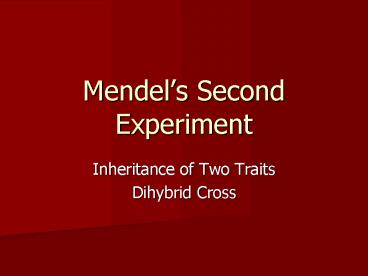Mendel
1 / 20
Title: Mendel
1
Mendels Second Experiment
- Inheritance of Two Traits
- Dihybrid Cross
2
Monohybrid Review
- How many traits were being looked at during the
Mendels monohybrid cross? - The cross was between one trait only
- What was being crossed in Mendels monohybrid
cross? - Two purebred organisms for the first cross
- Two F1 Heterozygote organisms in the second
3
Back Track for a Second
- What exactly was a purebred species in terms of
genotype? - It was a species that had the same alleles in in
its genetic makeup (either BB or bb) - What about a hybrid species in terms of genotype?
- It was a species that had different alleles in
its genetic makeup (like Bb)
4
P X P
- When the two parents were crossed, BB X bb, what
resulted? - The Results were four heterozygous offspring.
- These are the F1 generation
5
F1 X F1
- When the two F1 generation were crossed, BB X bb,
what resulted? - The Results were three dominant and one recessive
in a 31 phenotypic ratio but in a 121
genotypic ratio - These are the F2 generation
6
The Law of Segregation
- What does the Law of Segregation state?
- It states that inherited traits are determined by
pairs of factors - These factors segregate (separate) in the gametes
7
What happened next?
- Mendel completed the monohybrid cross and started
to ask and formulate new questions - What do you think he was thinking of next?
- He wanted to know if the inheritance of one
characteristic influenced the inheritance of a
different characteristic
8
What did he try next?
- He started all over again
- He produced purebred plants just like last time
with the traits he wanted to examine - He bred pea plants that were round and yellow
pure plants (dominant for both) and then he did
the same for wrinkled and green (recessive for
both)
9
What did he try next?
- He then crossed them again
- The P X P ended up yielding what?
- The F1 ended up being all yellow and all round,
just like last time - There seems to be some similarity
10
P X P Dihybrid Cross
RY RY RY RY
ry RrYy RrYy RrYy RrYy
ry RrYy RrYy RrYy RrYy
ry RrYy RrYy RrYy RrYy
ry RrYy RrYy RrYy RrYy
11
Then What?
- Just like last time he crossed the two F1 Progeny
- What do you think he got?
- He got 9 Yellow and round
- He got 3 Green and round
- He got 3 Yellow and Wrinkled
- He got 1 Green and Wrinkled
12
Whats The Ratio?
- The ratio that he got was?
- 9331
13
(No Transcript)
14
How to determine the Gametes
- Think Back to Grade 9 math (or before maybe)
- What was foil?
- (x n) (y z) xy xz ny nz
15
Same rule applies
- When looking at the genotypes of the parents to
identify the possible gametes perform the same
type of foil as we do in math - RrYy RY Ry rY ry
16
How Many?
- How many plants do you think that Mendel used for
this experiment - 551 pea plants
- And of that 551 this was the ratio that he got
- 320 round and yellow
- 104 round and green
- 101 wrinkled and yellow
- 26 wrinkled and green
17
What did this tell him?
- The ratio of 9331 could be explained if the
alleles from one trait were inherited
independently of the alleles for another trait - The Law of Independent Assortment
18
The Law of Independent Assortment
- The second law of inheritance states that the
inheritance of alleles for one trait does not
affect the inheritance of alleles for another
trait - Different pairs of alleles are passed to the
offspring independently of each other
19
The Law of Independent Assortment
- This means that offspring may have new
combinations of alleles that are not present in
either parent
20
Class Work
- Read Pages 136 140 (including the Sample
problem on page 140) - Complete questions 1-9 on page 141
- Complete questions 1-3 on page 29 (course pack)































